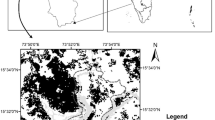Abstract
The present study deals with the occurrence of vesicular arbuscular mycorrhizal fungi in three cultivars of rice in Barak valley. Three cultivars of rice were Pankaj, Malati and Ranjit. The results revealed the association of VAM fungi in all the cultivars of rice. The association was maximum in Pankaj cultivar followed by Malati, and Ranjit, respectively, in all the three sampling phases. All the three cultivars of rice crop showed maximum soil spore population and number of VAM fungal species at the harvesting phase (135 DAS) and minimum at the phase of maturation (90 DAS). Glomus species were found dominating followed by Acaulospora species. Glomus microcarpum, Glomus claroideum, Glomus mosseae and Acaulospora scrobiculata were found in all the three fields.
Similar content being viewed by others
References
Mohadevan A, Rahman N, Natarajan K (1988) Mycorrhizae for green Asia. University of Madras, Madras
Shrivastava D, Kapoor R, Shrivastava SK, Mukherji KA (1996) Vesicular arbuscular mycorrhiza—an overview. In: Mukherji KG (ed) Kluwer Academic Publishers, Netherlands. p.1–39
Krishna KR, Bagyaraj DJ (1982) Influence of vesicular-arbuscular mycorrhiza on growth and nutrition of Arachis hypogea. Legume Res 5:18–22
Katiyar RS, Das PK, Chowdhury PC, Ghosh A, Singh GB, Datta RK (1994) Response of irrigated mulberry (Morus alba L.) to VA mycorrhizal inoculation under graded doses of phosphorus. Plant Soil 5:369–373
Rao VP, Pawar SE, Singh SN (1995) Production and application of vesicular-arbuscular mycorrhizal inocula for sustainable agriculture. In: Adholaya A, Singh S (eds) Mycorrhizae Biofertilizer for the Future. TERI Publication, New Delhi, pp 424–428
Bagyaraj DJ, Varma V (1995) Interaction between arbuscular mycorrhizal fungi and plants. Their importance in sustainable agriculture and in arid and semiarid tropics. In: Advances in microbial ecology, Academic Press, London, pp 119–142
Maiti D, Variar M, Saha J (1995) Colonization of upland rice by native VAM under rainfed monocropped ecosystem. In: Roy AK, Sinha KK (eds) Recent advances in phytopathological research, MD Publication, New Delhi, pp 45–51
Saha R, Saha J, Bhattacharya PM, Maiti D, Chowdhury S (1999) Arbuscular mycorrhizal responsiveness of two varieties in nutrient deficient laterite soil (abstr.). In: Proc Nat Conf on Mycorrhiza, Barkhatullah University, Bhopal, pp 28, 5–7 March 1999
Dubey A, Mishra MK, Singh PK, Vyas D (2008) Occurrence of AM fungi at varying stages of growth of rice plants. Proc Nat Acad Sci Ind 78(1):51–55
Yeasmin T, Zaman P, Rahman A, Absar N, Khanum NS (2008) Arbuscular mycorrhizal fungus inoculum production in rice plants. African J Agri Res 2:463–467
Gerdemann JW, Nicolson TH (1963) Spores of mycorrhizal endogone extracted from soil by wet sieving and decanting. Trans Br Mycol Soc 46:235–244
Daniels BA, Skipper HD (1982) Methods for the recovery and quantitative estimation of propagules from soil. In: Schenck NC (ed) Methods and principles of mycorrhizal research. The American Phytopathological Society, St. Paul, pp 20–40
Phillips JM, Hayman DJ (1970) Improved procedures for clearing and staining parasitic and vesicular-arbuscular mycorrhizal fungi for rapid assessment of infection. Trans Br Mycol Soc 55:158–161
Giovannetti M, Mosse (1980) An evaluation of techniques for measuring vesicular arbuscular mycorrhizal infection in roots. New Phytol 84:489–500
Allen SE (1974) Chemical analysis of ecological materials. Blackwell Scientific Publications, New Delhi
Piper CS (1966) Soil and plant analysis (Asian Edition). Hans Publishers, Bombay, pp 189–245
Subbiah BV, Asija GL (1956) A rapid procedure for the determination of available nitrogen in soils. Curr Sci 25:259–260
Bray RH, Kurtz LT (1945) Determination of total organic and available forms of phosphorus in soils. Soil Sci 59:39–45
Datta ND, Khera MS, Saini TR (1962) A rapid colorimetric procedure for the determination of the organic carbon in soils. J Indian Soc Soil Sci 10:67–74
Mosse B (1973) Advances in the study of vesicular arbuscular mycorrhiza. Annu Rev Phytopathol 11:171–196
Deb Roy B, Deb B, Sharma GD (2009) Diversity of soil diazotrophs in acid stress rice agroecosystems of Barak valley of Assam, India. J Pure Appl Microbiol 3:117–124
Rao VR, Ramakrishnan B, Adhya TK, Kanungo PK, Nayak DN (1998) Review: current status and future prospects for associative nitrogen fixation in rice. World J Microbiol Biotechnol 14:621–633
Ilag LL, Rasales AN, Elazegui FA, Mew TW (1987) Changes in the population of infective endomycorrhizal fungi in a rice based cropping system. Plant Soil 103:67–73
Vyas D, Dubey A, Singh PK, Mishra MK, Gupta RK (2006) Distribution of VAM Fungi in two different rice crop fields. J Bot Soc Univ Sagar 41:160–170
Mosse B (1975) Specificity in vesicular-arbuscular mycorrhizae. In: Sanders FE, Mosse B, Tinker PB (eds) Endmycorrhizas. Academic Press, London, pp 469–484
Hayman DS (1983) The physiology of vesicular arbuscular endo-mycorrhizal symbiosis. Can J Bot 61:944–963
Hepper C M (1985) Vesicular arbuscular mycorrhiza. In: Powell CL, Bagyaraj DJ (eds) CRC Press, Florida, p 5–112
Chandra KK, Jamaluddin (1999) Distribution of vascular arbuscular mycorrhizal fungi in coal mine overburden dumps. Indian Phytopathol 52(3):254–258
Sutton JC (1973) Development of vesicular-arbuscular mycorrhizae in crop plants. Can J Bot 50:1909–1914
Smith SE, Walker NA (1981) A quantitative study of mycorrhizal infection in Trifolium: separate determination of the rates of infection and of mycelial growth. New Phytol 89:225–240
Sanders FE, Sheikh NA (1983) The development of vesicular-arbuscular mycorrhizal infection in plant root systems. Plant Soil 71:223–246
Muthukumar T, Udaiyan K (2000) Arbuscular mycorrhiza of plants growing in the Western Ghats region, Southern India. Mycorrhiza 9:297–313
Bhattacharya S, Bagyaraj DJ (2002) Arbuscular mycorrhizal fungi associated with Arabica coffea. Geobios 29:93–96
Monoharachary C, Sridhar K, Singh R, Adholeya A, Suryanarayanam TS, Rawat S, Johri BN (2005) Fungal biodiversity, distribution, conservation and prospecting of fungi from India. Curr Sci 89:1
Acknowledgments
Authors are thankful to HOD, Department of Life Science, Assam University for extending all sorts of support to undertake the investigation etc.
Author information
Authors and Affiliations
Corresponding author
Rights and permissions
About this article
Cite this article
Bhattacharjee, S., Sharma, G.D. The Vesicular Arbuscular Mycorrhiza Associated with Three Cultivars of Rice (Oryza sativa L.). Indian J Microbiol 51, 377–383 (2011). https://doi.org/10.1007/s12088-011-0090-9
Received:
Accepted:
Published:
Issue Date:
DOI: https://doi.org/10.1007/s12088-011-0090-9




